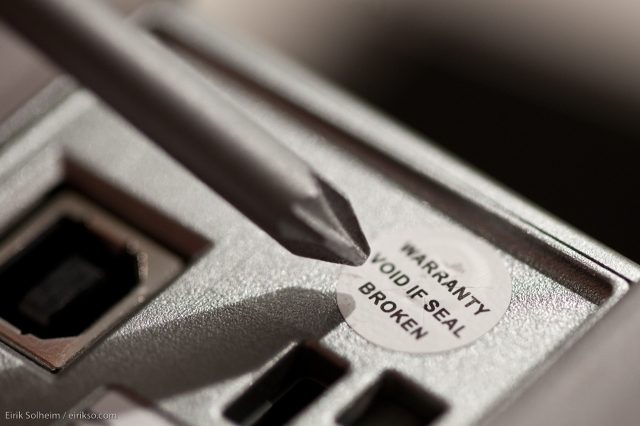Kelsea Weber is apologetic for being hard to get ahold of. “We were all busy tearing down the iPhone XS,” she says.
A few minutes conversation with Kelsea is enough to convince you that she would be taking apart brand new Apple gear no matter what, but she does it professionally. Weber works for iFixit.com, a website you may have heard of once or twice. It provides repair videos, manuals, and tool kits to more than a hundred million visitors a year.
Or, to put it bluntly: iFixit.com is essentially a clearinghouse for information that some of the big names in consumer electronics would just as soon keep to themselves.
In the US, manufacturers in everything from consumer technology to farming and agriculture have long constructed systems that limit where customers can go for repairs—remember the old “warranty void if broken” stickers found on game consoles or TVs? Today if you have a broken iPhone screen, for instance, Apple runs Genius Bars across the country where users must go for permitted fixes. Other companies parcel work out to a network of authorized vendors. Manufacturers generally argue these constraints are necessary to protect proprietary information that gives their product a leg up in the overall marketplace.
Slowly but surely, though, consumers and third parties outside of vendor-sanctioned circles have been pushing to change this through so-called “right to repair” laws. These pieces of proposed legislation take different forms—19 states introduced some form of right to repair legislation in 2018, up from 12 in 2017—but generally they attempt to require companies, whether they are in the tech sector or not, to make their service manuals, diagnostic tools, and parts available to consumers and repair shops—not just select suppliers.
Its difficult to imagine a more convincing case for the notion that politics make strange bedfellows. Farmers, doctors, hospital administrators, hackers, and cellphone and tablet repair shops are aligned on one side of the right to repair argument, and opposite them are the biggest names in consumer technology, ag equipment and medical equipment. And given its prominence in the consumer technology repair space, IFixit.com has found itself at the forefront of the modern right to repair movement.

How the repair world became in need of repair
“The problem is that there are only two types of transaction in the United States: purchases and licenses,” says Gay Gordon-Byrne, the executive director of the Repair Association, a right to repair advocacy group partnering with iFixit to further the movement. “You dont own something if its covered by an end-user license agreement. All you have is a right to use it according to the manufacturers terms.”
Initially part of the personal computer revolution, end-user license agreements came into their own in the 1980s. Copyright laws that had worked reasonably well when it came to books and movies didnt work as well when it came to software. Copyright laws apply only to software code. They dont apply to the features and functionality of a program. So before license agreements, a software purchaser could reverse-engineer software and create a program with substantially the same functionality, leaving it to the courts to determine if there had been any infringement—a costly and time-consuming process.
End user license agreements were seen as an effective way to solve those problems in a simple and straightforward manner. For almost all software users, the switch from owning software to just having a license to use it was quite painless. Nothing changed in practice: the software still came in a box with manuals and disks, and thRead More – Source
[contf] [contfnew] 
Ars Technica
[contfnewc] [contfnewc]







